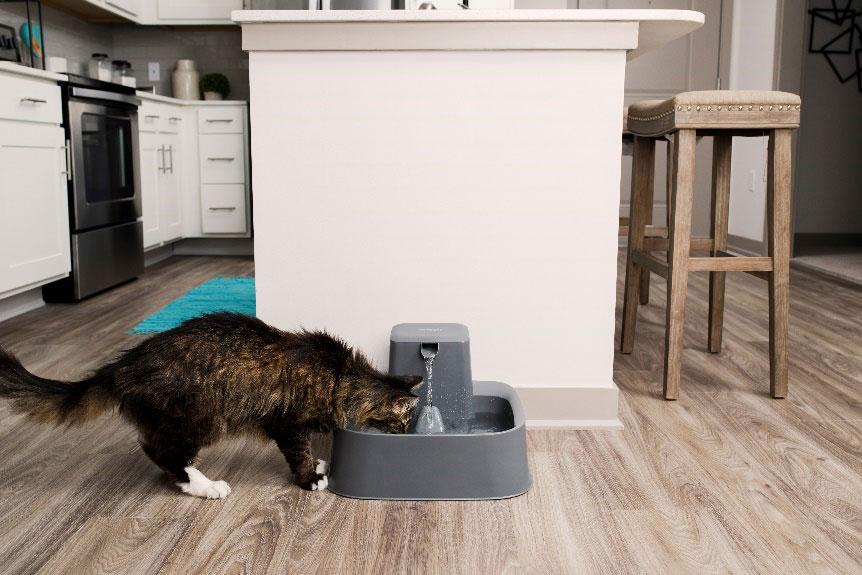Dehydration creeps up stealthily, like a slow-moving brush fire that suddenly blossoms into a major blaze, causing major problems. Dehydration, like fire, is best fought with water. Lots of water. And it’s best to apply that water before a physical crisis engulfs your cat or dog and you are suddenly faced with very sick fur babies.
A good rule of thumb to meet your pets' water needs is the 1:1 ratio. This means your dog or cat needs at least one ounce of water per pound of body weight every day. This is doubly essential in the summer, when dogs and cats can become overheated and rapidly deplete their water supply, both internally and externally.
The bodies of most pets are about 80-percent water. If a pet loses 10 percent or more of his or her body weight in water, deadly dehydration can result as kidneys shut down and the heart works overtime to get blood where it needs to go.
The best treatment for dehydration is to avoid it in the first place. That’s why PetSafe® Drinkwell® dog and cat fountains are a great go-to for busy pet parents to ensure their pets receive adequate amounts of fresh, filtered water. A cat fountain or high-volume dog water fountain doesn’t need to be refilled as often as a dirty steel bowl on the kitchen floor. It’s also a lot more palatable to pets. These both add up to a largely hands-off approach to pet hydration that is perfect for busy pet parents. If your dogs or cats are left outside during the heat of the day, an outdoor pet fountain is essential.
Cats especially love running water because it's usually the freshest and cleanest source in nature. Drinkwell® and PetSafe® fountains provide a source of perpetually running water that stimulates a cat's desire for fresh, clean water in a convenient, way. Hydration in cats is of particular importance because of common issues with their urinary tract health. Providing sources of water they'll actually drink is an important step in preventing urinary obstructions. While dogs aren’t quite as finicky as kitties, they will be more inclined to drink from a fountain than some dirty dog water bowl.
How to tell if your pet is dehydrated
Despite the best efforts of the best pet parents, there are times when cats or dogs may become dehydrated. Here are some signs of pet dehydration:
- Dry mouth: Are the tongue and gums moist or dry? If they are dry, there is a chance your pet may be dehydrated. Is the saliva thick and ropey? Normally, saliva is quite watery and hardly noticeable.
- Sunken eyes: Are they normal, or do they sink into the sockets? Do the corneas (the clear part at the front of the eye) appear shiny and moist, or are they dry and dull? Sunken, dull or dry eyes may indicate dehydration.
- Malleable skin: The 'skin turgor test' is used by vets to check for dehydration. To perform this test, gently pinch a fold of skin over the shoulder blades and raise it up an inch or so and then check how quickly it returns to its normal position. If a pet is fully hydrated, the skin snaps back into position almost immediately. If the skin is slow to return to position, your pet may be moderately to severely dehydrated. If the skin does not return fully to its position, your pet may be severely dehydrated and may be in critical condition. Seek veterinary attention immediately. The skin test is not always accurate and several factors such as age, weight loss, and skin condition can give misleading results.
Treating pet dehydration
Your veterinarian can help you determine how dehydrated your pet is, what the cause may be, and the best course of treatment. If in doubt, always have your pet evaluated by a veterinarian. Just like in humans, pet dehydration can be caused by illnesses that cause vomiting, diarrhea, hypothermia (low body temperature) and fever. Veterinarians rely on physical exam findings to evaluate pets for dehydration, but in some cases laboratory tests are needed to really find out how dehydrated a pet is and determine the cause. Here are some treatment options:
- Slow-roll hydration: If you think your dog or cat is only slightly dehydrated, and they are alert and not vomiting, give frequent, small amounts of water by mouth. Offer about 1 teaspoon for a cat or small dog to 1 tablespoon to 1/4 cup for a medium to large dog every few hours.
- Call your vet: If you think your pet has moderate or severe dehydration, call your vet.
- Keep an eye out: If your pet is lethargic, in pain, or has not eaten for 24 hours, or is vomiting and appears dehydrated, call your vet immediately.
Your vet can have your dehydrated fur babies back in your arms fairly quickly, but preventing dehydration in the first place is the best way to ensure good health in the heat of summer and all year long.
Keep that slow burn of dehydration at bay this summer with PetSafe® Drinkwell® dog and cat fountains and Leave it to PetSafe.







